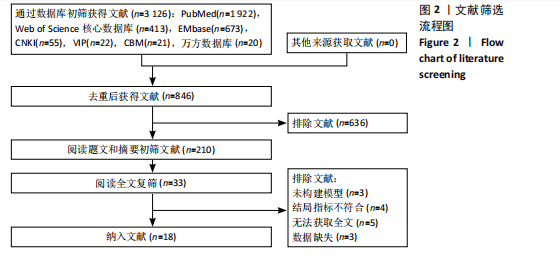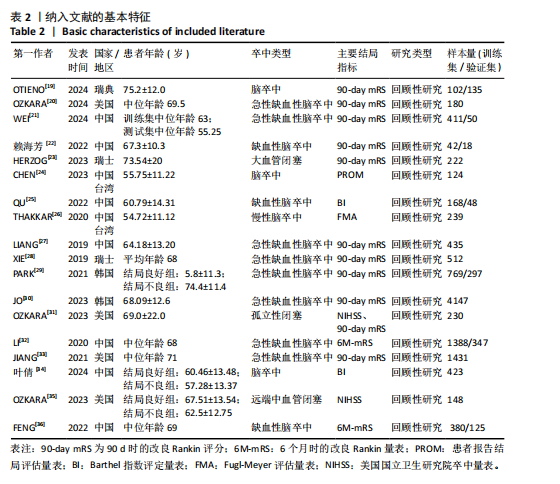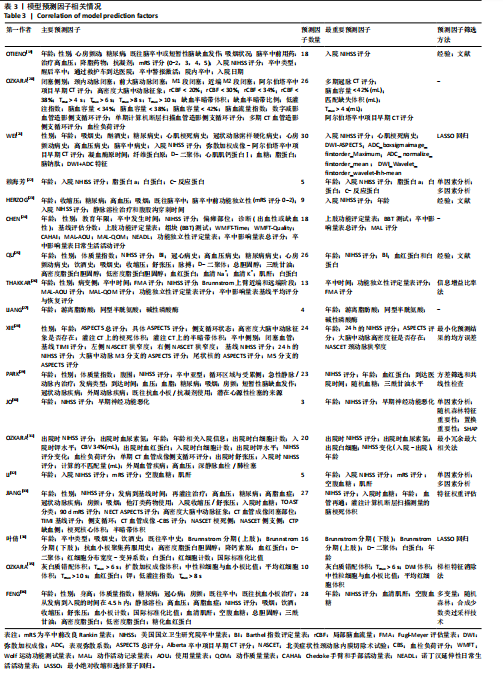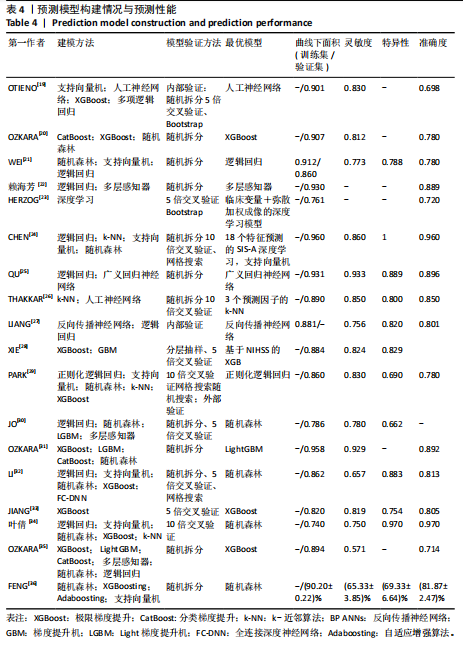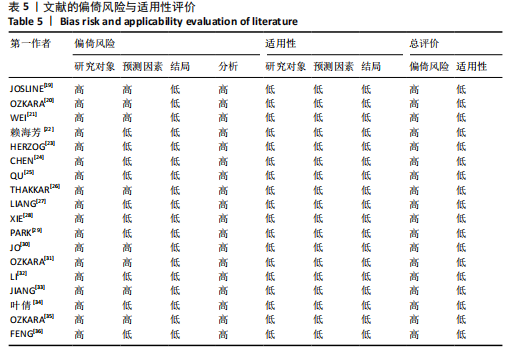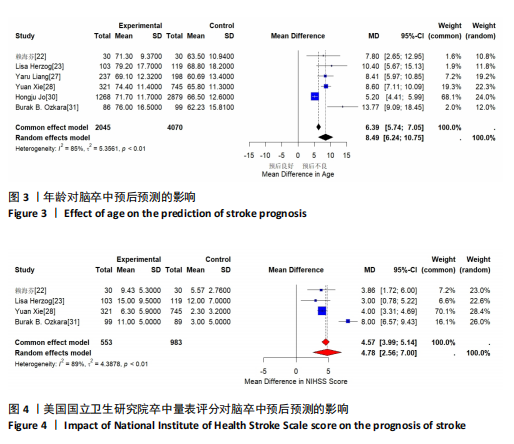[1] KATAN M, LUFT A. Global Burden of Stroke. Semin Neurol. 2018;38(2):208-211.
[2] GBD 2019 STROKE COLLABORATORS. Global, regional, and national burden of stroke and its risk factors, 1990-2019: a systematic analysis for the Global Burden of Disease Study 2019. Lancet Neurol. 2021;20(10):795-820.
[3] WINTERS C, KWAKKEL G, VAN WEGEN E, et al. Moving stroke rehabilitation forward: The need to change research. Neuro Rehabilitation. 2018;43(1):19-30.
[4] YUFE R. Stroke prognostication using age and NIH Stroke Scale: SPAN-100. Neurology. 2013,81(6):603.
[5] CHEN LL, YAN SM, WANG WT, et al. Cohort study of THRIVE predicting adverse outcomes in acute ischemic stroke of the anterior circulation and posterior circulation after 3 months and 1 year of follow-up. J Clin Neurosci. 2022;96:33-37.
[6] COLAlILLO JM, SMITH J. Artificial intelligence in medicine: The rise of machine learning. Emerg Med Australas. 2024;36(4):628-631.
[7] OBERMEYER Z, EMANUEL EJ. Predicting the Future - Big Data, Machine Learning, and Clinical Medicine. N Engl J Med. 2016; 375(13):1216-1219.
[8] BONKHOFF AK, GREFKES C. Precision medicine in stroke: towards personalized outcome predictions using artificial intelligence. Brain. 2022;145(2):457-475.
[9] WANG W, RUDD AG, WAN Y, et al. Risk prediction of 30-day mortality after stroke using machine learning: a nationwide registry-based cohort study. BMC Neurol. 2022;22(1):195.
[10] WANG W, OTIENO J A, ERIKSSON M, et al. Developing and externally validating a machine learning risk prediction model for 30-day mortality after stroke using national stroke registers in the UK and Sweden. BMJ Open. 2023;13(11):e69811.
[11] WENG SF, REPS J, KAI J, et al. Can machine-learning improve cardiovascular risk prediction using routine clinical data? PLoS One. 2017;12(4):e174944.
[12] ORFANOUDAKI A, CHESLEY E, CADISCH C, et al. Machine learning provides evidence that stroke risk is not linear: The non-linear Framingham stroke risk score. PLoS One. 2020;15(5):e232414.
[13] KATARIA S, RAVINDRAN V. Electronic health records: a critical appraisal of strengths and limitations. J R Coll Physicians Edinb. 2020;50(3):262-268.
[14] REDDY S. Explainability and artificial intelligence in medicine. Lancet Digit Health. 2022;4(4):e214-e215.
[15] KUNDU S. AI in medicine must be explainable. Nat Med. 2021;27(8):1328.
[16] MORLEY J, MACHADO C, BURR C, et al. The ethics of AI in health care: A mapping review. Soc Sci Med. 2020;260:113172.
[17] MOONS KG, DE Groot JA, BOUWMEESTER W, et al. Critical appraisal and data extraction for systematic reviews of prediction modelling studies: the CHARMS checklist. PLoS Med. 2014;11(10):e1001744.
[18] WOLFF RF, MOONS K, RILEY RD, et al. PROBAST: A Tool to Assess the Risk of Bias and Applicability of Prediction Model Studies. Ann Intern Med. 2019;170(1):51-58.
[19] OTIENO JA, HÄGGSTRÖM J, DAREHED D, et al. Developing machine learning models to predict multi-class functional outcomes and death three months after stroke in Sweden. PLoS One. 2024;19(5):e303287.
[20] OZKARA BB, KARABACAK M, HOSEINYAZDI M, et al. Utilizing imaging parameters for functional outcome prediction in acute ischemic stroke: A machine learning study. J Neuroimaging. 2024;34(3):356-365.
[21] WEI L, PAN X, DENG W, et al. Predicting long-term outcomes for acute ischemic stroke using multi-model MRI radiomics and clinical variables. Front Med (Lausanne). 2024;11:1328073.
[22] 赖海芳, 顾琳, 纵亚, 等. 采用多层感知器神经网络构建亚急性期缺血性脑卒中患者短期预后的预测模型[J]. 中国康复理论与实践,2022,28(3):335-339.
[23] HERZOG L, KOOK L, HAMANN J, et al. Deep Learning Versus Neurologists: Functional Outcome Prediction in LVO Stroke Patients Undergoing Mechanical Thrombectomy. Stroke. 2023;54(7):1761-1769.
[24] CHEN YW, LIN KC, Li YC, et al. Predicting patient-reported outcome of activities of daily living in stroke rehabilitation: a machine learning study. J Neuroeng Rehabil. 2023;20(1):25.
[25] QU S, ZHOU M, JIAO S, et al. Optimizing acute stroke outcome prediction models: Comparison of generalized regression neural networks and logistic regressions. PLoS One. 2022;17(5):e267747.
[26] THAKKAR HK, LIAO WW, WU CY, et al. Predicting clinically significant motor function improvement after contemporary task-oriented interventions using machine learning approaches. J Neuroeng Rehabil. 2020;17(1):131.
[27] LIANG Y, LI Q, CHEN P, et al. Comparative Study of Back Propagation Artificial Neural Networks and Logistic Regression Model in Predicting Poor Prognosis after Acute Ischemic Stroke. Open Med (Wars). 2019; 14:324-330.
[28] XIE Y, JIANG B, GONG E, et al. JOURNAL CLUB: Use of Gradient Boosting Machine Learning to Predict Patient Outcome in Acute Ischemic Stroke on the Basis of Imaging, Demographic, and Clinical Information. AJR Am J Roentgenol. 2019; 212(1):44-51.
[29] PARK D, JEONG E, KIM H, et al. Machine Learning-Based Three-Month Outcome Prediction in Acute Ischemic Stroke: A Single Cerebrovascular-Specialty Hospital Study in South Korea. Diagnostics (Basel). 2021;11(10):1909.
[30] JO H, KIM C, GWON D, et al. Combining clinical and imaging data for predicting functional outcomes after acute ischemic stroke: an automated machine learning approach. Sci Rep. 2023;13(1):16926.
[31] OZKARA BB, KARABACAK M, HAMAM O, et al. Prediction of Functional Outcome in Stroke Patients with Proximal Middle Cerebral Artery Occlusions Using Machine Learning Models. J Clin Med. 2023;12(3):839.
[32] LI X, PAN X, JIANG C, et al. Predicting 6-Month Unfavorable Outcome of Acute Ischemic Stroke Using Machine Learning. Front Neurol. 2020;11:539509.
[33] JIANG B, ZHU G, XIE Y, et al. Prediction of Clinical Outcome in Patients with Large-Vessel Acute Ischemic Stroke: Performance of Machine Learning versus SPAN-100. AJNR Am J Neuroradiol. 2021;42(2):240-246.
[34] 叶倩, 杨云, 徐文韬, 等. 基于可解释机器学习构建脑卒中患者日常生活自理能力风险预测模型[J]. 南京医科大学学报(自然科学版),2024,44(5):672-680.
[35] OZKARA BB, KARABACAK M, KOTHA A, et al. Development of machine learning models for predicting outcome in patients with distal medium vessel occlusions: a retrospective study. Quant Imaging Med Surg. 2023;13(9):5815-5830.
[36] FENG X, HUA Y, ZOU J, et al. Intelligible Models for HealthCare: Predicting the Probability of 6-Month Unfavorable Outcome in Patients with Ischemic Stroke. Neuroinformatics. 2022;20(3):575-585.
[37] ROY-O’REILLY M, MCCULLOUGH LD. Age and Sex Are Critical Factors in Ischemic Stroke Pathology. Endocrinology. 2018; 159(8):3120-3131.
[38] GALLIZIOLI M, ARBAIZAR-ROVIROSA M, BREA D, et al. Differences in the post-stroke innate immune response between young and old. Semin Immunopathol. 2023;45(3):367-376.
[39] KWAH LK, DIONG J. National Institutes of Health Stroke Scale (NIHSS). J Physiother. 2014;60(1):61.
[40] COMER AR, TEMPLETON E, GLIDDEN M, et al. National Institutes of Health Stroke Scale (NIHSS) scoring inconsistencies between neurologists and emergency room nurses. Front Neurol. 2022;13:1093392.
[41] NAM D, CHAPIRO J, PARADIS V, et al. Artificial intelligence in liver diseases: Improving diagnostics, prognostics and response prediction. JHEP Rep. 2022;4(4):100443.
[42] SAMAD MD, ABRAR S, DIAWARA N. Missing Value Estimation using Clustering and Deep Learning within Multiple Imputation Framework. Knowl Based Syst. 2022;249:108968. |
